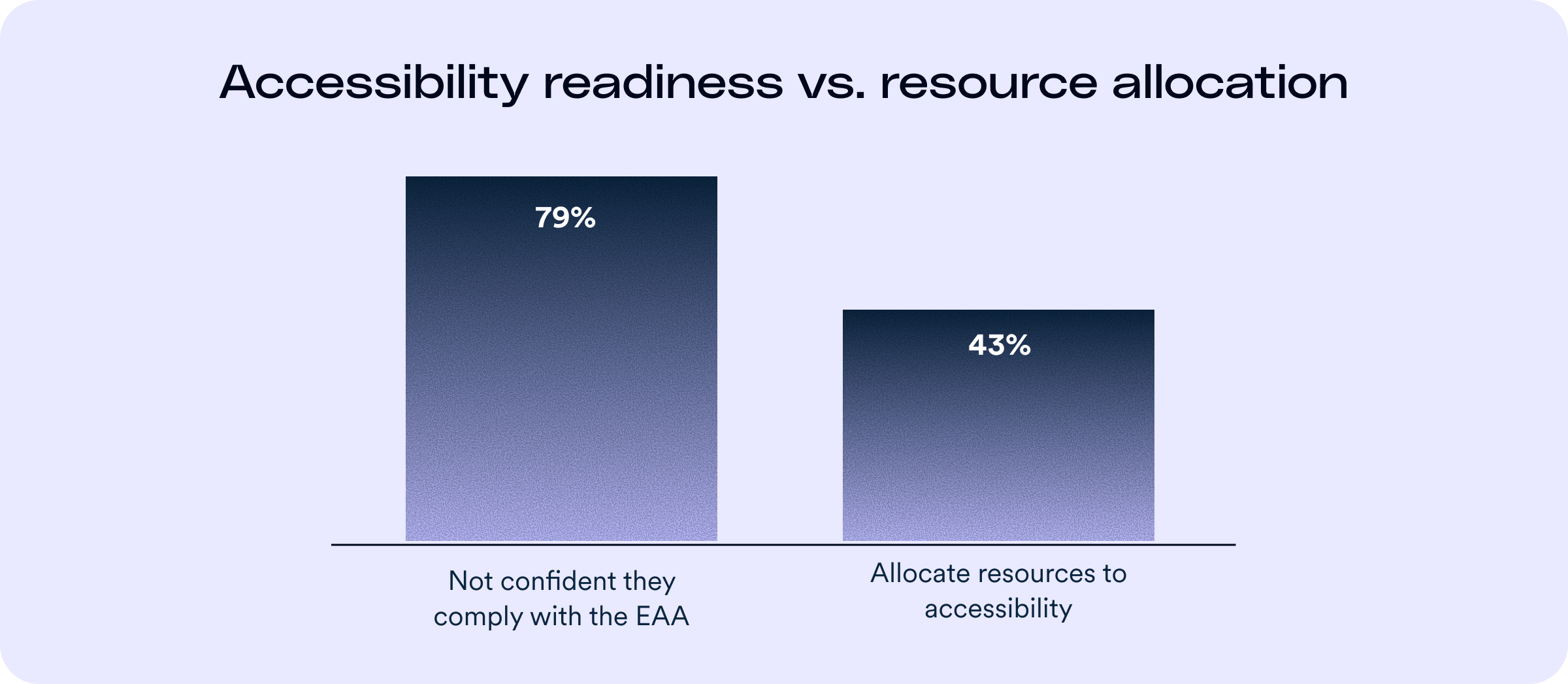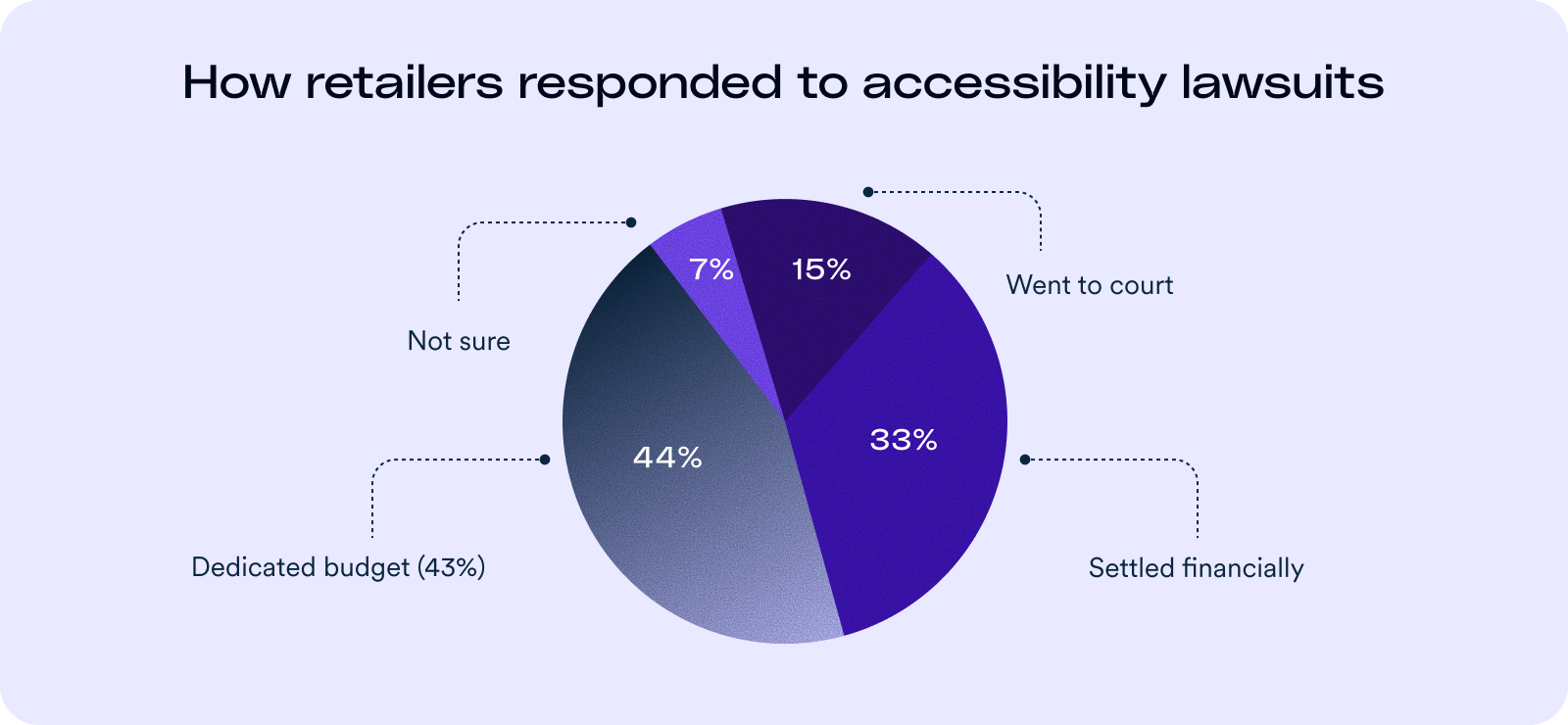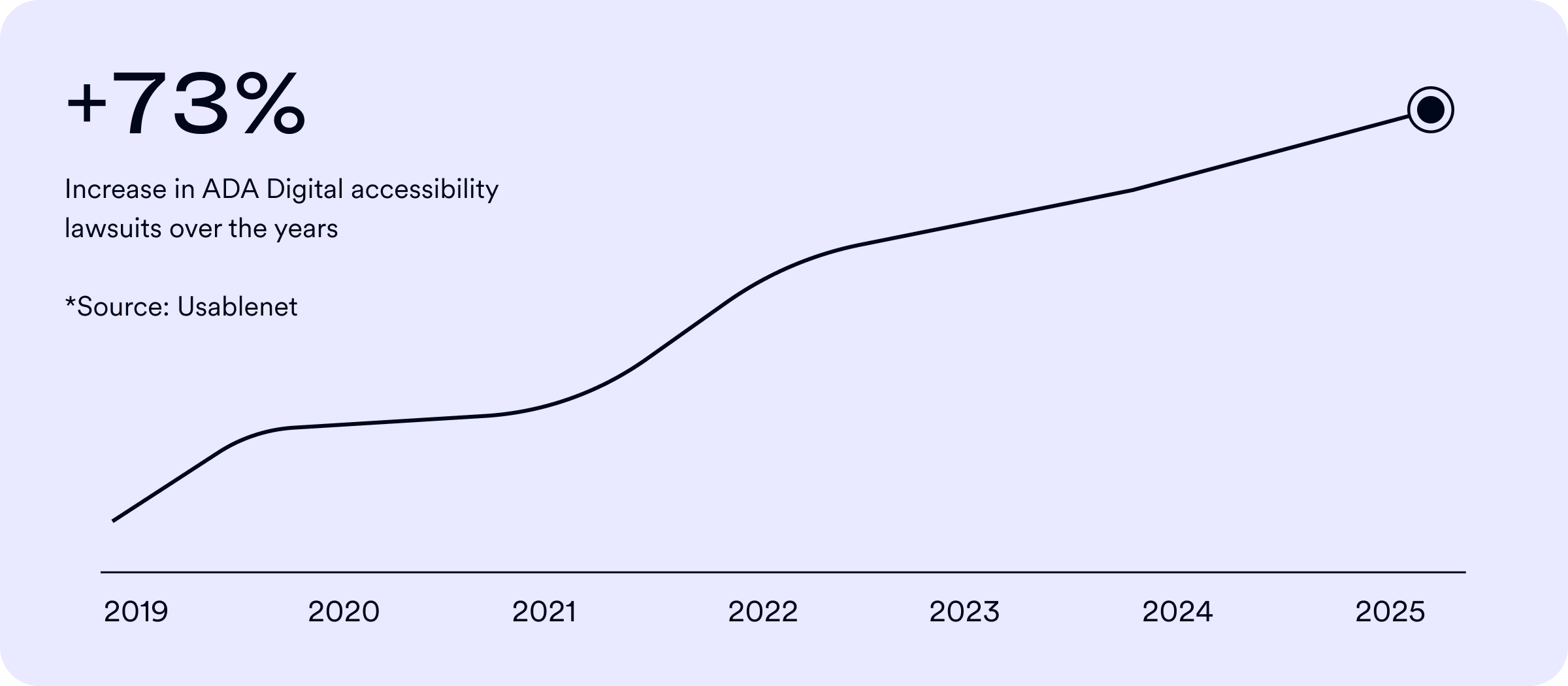About the research
Our eCommerce trends survey - conducted with Qualtrics, non-profit leaders, and disability community organizations - captured insights from over 300 eCommerce leaders and members of the disability community. The findings reveal how legal, financial, and reputational pressures are shaping accessibility priorities as enforcement and litigation accelerate, with litigation and regulatory exposure emerging as the most urgent challenge for retailers.
2Legal risk intensifies for eCommerce
Failure to meet accessibility requirements online has become a major legal and financial risk for eCommerce. Retail sites are transactional, dynamic, and highly visible, which makes accessibility gaps both easy to detect and costly to ignore. Plaintiffs can quickly identify issues like broken filters, unlabeled fields, or inaccessible pop-ups, and in multi-step checkouts, even a single barrier can block an entire purchase.
The numbers show the growing legal risk:
- In 2025, nearly 5,000 lawsuits, a 20% increase from 2024
- 77% of all cases in 2024 targeted online retailers, and 2025 followed a similar pattern
- 97% of cases settle, typically costing $5K–$25K each, not including remediation or reputational damage
It is no wonder that 71% of survey respondents report concern about digital accessibility-related legal risks, under laws like the Americans with Disabilities Act (ADA), the European Accessibility Act (EAA), and other regulations. Yet, only 43% allocate resources to improve their digital platforms’ accessibility status and mitigate risk.
For law firms specializing in accessibility claims, eCommerce has become an easy and frequent target, where every unresolved barrier can serve as both a legal trigger and a lost conversion.

As standards tighten, lawsuits rise
Accessibility litigation is accelerating, and eCommerce continues to face the highest risk. By mid-2025, lawsuits were already outpacing 2024, with both large and small retailers increasingly under scrutiny.
At the same time, regulators worldwide are reinforcing accessibility as a legal requirement, making WCAG 2.1 AA the clear global standard.
What the lawsuit landscapeshowed in 2025:
- 2,019 lawsuits filed by midyear, reaching 4,975 by year-end (+20% YoY)
- eCommerce remains the epicenter (69%), with food service (18%) and other industries making up the rest
- Retailers of every size are being targeted
*Source: Usablenet
Case examples stretch across the spectrum. Amazon was sued over screen reader barriers, Domino’s Pizza was forced to remediate its website and app, and Dania Furniture, a mid-sized chain, was ruled liable in an accessibility lawsuit. Accessibility litigation is not confined to big brands and household names; small and regional retailers are also being pulled into the same legal spotlight.

Nearly half of surveyed eCommerce leaders have already faced accessibility-related legal action. Here’s how they responded:

The regulatory environment adds another layer of pressure. In the U.S., the Department of Justice has reaffirmed that ADA Title III applies to websites, citing WCAG as the standard, while courts continue to rule that websites are places of public accommodation.
In the EU, the European Accessibility Act (2025) has expanded requirements across all consumer-facing services, eCommerce included. Canada’s ACA and AODA and the UK Equality Act add further obligations.
Together, these developments have made WCAG 2.1 AA the de facto global baseline, and retailers who fall short face exposure in every market where they sell.
Accessibility litigation is not confined to big brands and household names; small and regional online retailers are also being pulled into the same legal spotlight. |
The upside of access and the cost of inaction
Critical shopping flows like checkout and payment are among the most common areas cited in accessibility lawsuits and DOJ enforcement, because gaps there are both highly visible and easy to document. An unlabeled form field, missing alt text, or an inaccessible payment modal can all serve as proof of non-compliance—and each one also represents a missed conversion.
The benefits of accessible design:
- Compliance reduces exposure: Aligning with WCAG provides a defensible standard and mitigates the risk of legal action
- Accessibility boosts visibility: Proper use of alt text, headings, and structured navigation not only helps you meet compliance requirements but also strengthens SEO
- Inclusive brands build trust: Demonstrating a commitment to accessibility boosts brand reputation and strengthens customer loyalty
- Accessible sites convert: Reducing errors, friction, and barriers in checkout leads to more completed transactions and higher revenue
Accessibility is one of the few investments that directly manages legal risk while improving business performance. |
The risks of inaction:
- Mounting litigation costs: With 97% of cases settling, payouts of $5K–$25K quickly add up alongside legal fees
- Lost revenue. Every accessibility gap is both a legal trigger and a potential conversion leak
- Reputational damage: Public lawsuits and negative press erode customer trust and brand credibility
Repeat exposure: Unresolved barriers often appear in multiple suits until fully remediated
Accessibility is one of the few investments that helps manage legal risk while improving business performance. Each fix helps remove evidence a plaintiff could use in court, while also creating smoother, more discoverable, and more trusted customer experiences.
“Regulation is no longer a distant threat—it’s here, it’s global, and it’s costly. Retailers that delay accessibility risk facing fines and lawsuits that could have been avoided with proactive compliance.” - Josh Basile Esq., Community Relations Manager |
How eCommerce brands can manage litigation and regulatory risk
- Address accessibility early
Adding accessibility scans and audits to every campaign launch and site update reduces exposure before it reaches customers - or the courtroom. Proactive monitoring is cheaper than settlements and strengthens legal defense. - Focus on critical shopping flows
Product search, cart, and checkout are high-risk journeys. Testing these flows with screen readers and keyboard navigation helps prevent both conversion loss and the most common issues cited in lawsuits. There are plenty of solutions that can help you, such as accessiBe’s Manual testing & custom remediation (MTCR), which ensures that important user journeys like checkout paths are operable for all users. - Pay extra attention to frequent offenders
Pop-ups, carousels, filters, and modals are often where accessibility breaks down. Ensuring they have proper labels, logical focus order, and fallbacks closes off easy grounds for legal claims. - Follow the standard that regulators cite
Treat WCAG 2.1 AA as your baseline. It is consistently referenced by the DOJ, European Accessibility Act, and other global frameworks, making it the safest foundation for compliance. A hybrid approach, such as AI tools for scale and manual expertise for complex fixes, offers the most reliable path to compliance. - Document your compliance efforts
Audit reports, remediation logs, and testing records provide valuable evidence if challenged. Documentation demonstrates due diligence, proves your accessibility efforts, and can strengthen a defense in court. - Think global
With the EAA in Europe and ACA in Canada, compliance is not just a U.S. issue. Our survey shows that 71% of eCommerce leaders sell into the EU, placing the majority squarely within the scope of the European Accessibility Act. Yet 66% admit they are not fully prepared for the EAA, with 19% saying they are not prepared at all - a gap that leaves retailers exposed to fines and lawsuits across markets. International compliance is now table stakes for any brand with global ambitions.
It’s never too late to act. Even retailers who have already faced claims can mitigate risk by remediating barriers now, demonstrating good-faith compliance, and putting continuous monitoring in place.
Leverage expert litigation support when claims arise
Even businesses with accessible websites may face unwarranted lawsuits. What matters is how quickly and confidently you can respond. The legal risk isn’t just about lawsuits — it’s about being ready when they land. 8 in 10 retailers told us they want expert backup when lawsuits hit. That’s why litigation support is no longer optional — it’s essential.
- Accessibility documentation and audit reports to demonstrate compliance efforts
- In-house legal and accessibility experts to guide you every step of the way
- Our record speaks for itself: No customer has ever lost a case due to accessWidget not supporting their accessibility.
Case in point: In 2024, a New York plastic surgeon was sued under the ADA. With accessiBe’s support, he produced documentation and expert reports demonstrating accessibility efforts. The judge explicitly recognized accessWidget as a valid measure for improving accessibility and dismissed the case.
“accessiBe’s support was a tremendous help…Their prompt and thorough response was key in demonstrating our commitment to compliance and ultimately contributed to the dismissal of the case.” - Dr. Hidalgo |
Turn risk into resilience
Rising lawsuits, stricter regulations, and growing consumer expectations have made accessibility both a legal mandate and a business imperative. The path forward is clear: address accessibility proactively, starting with critical shopping flows like checkout, and align with WCAG 2.1 AA as the global baseline.
By fixing barriers before they become lawsuits, retailers not only reduce exposure and protect their reputation—they also create smoother, more trusted shopping experiences that drive revenue. Accessibility is compliance, risk management, and growth strategy in one.
Frequently asked questions about accessibility lawsuits and e-commerce
Q1. Why are eCommerce websites facing more accessibility lawsuits than other industries?
A1. eCommerce sites are full of dynamic, interactive elements—filters, product galleries, carousels, pop-ups, and multi-step checkout flows. These components frequently introduce accessibility barriers, making online retailers especially vulnerable to legal action. Their high visibility, constant updates, and revenue-critical user journeys also make them a prime target for litigation.
Q2. Which laws and standards shape accessibility requirements for eCommerce businesses?
A2. In the U.S., eCommerce accessibility obligations stem primarily from ADA Title III, which requires public-facing websites to be accessible. In Europe, the European Accessibility Act (EAA) sets similar requirements, and in Canada the AODA applies. While these laws create the legal duty, WCAG 2.1 Level AA is the standard most commonly used to determine whether a website meets those obligations.
Q3. What types of accessibility failures trigger lawsuits for eCommerce businesses?
A3. Frequent triggers include inaccessible checkout flows, missing alt text on product images, low-contrast buttons or links, keyboard navigation failures, inaccessible menus, and screen-reader issues with product details or interactive components. Any barrier that prevents a user with a disability from completing a purchase can expose a retailer to legal risk.
Q4. What are the consequences for an eCommerce brand that faces an accessibility lawsuit?
A4. Consequences often include financial settlements, mandatory remediation, legal expenses, operational disruption, and reputational damage. Brands may also experience cart abandonment and revenue loss when accessibility barriers disrupt the customer journey.
Q5. Does using an accessibility overlay or widget protect an eCommerce site from lawsuits?
A5. No. Lawsuits have repeatedly been filed against sites using overlays or widgets alone. These tools do not fix underlying code-level issues that impact assistive-technology users. Courts typically expect accessibility to be addressed through WCAG-aligned remediation and ongoing governance—not a single add-on.
Q6. What steps can eCommerce businesses take to reduce accessibility-related litigation risk?
A6. Start with a full accessibility audit, prioritizing checkout, navigation, product discovery, filters, and mobile flows. Remediate high-impact issues, integrate accessibility into design and development workflows, maintain continuous monitoring, and document all accessibility efforts. Treat accessibility as part of your risk-management and customer-experience strategy.
Q7. How can accessiBe help eCommerce brands manage accessibility and reduce lawsuit exposure?
A7. accessiBe provides end-to-end accessibility solutions that combine AI-powered scanning, automated fixes for common barriers, expert manual remediation for complex flows, and continuous monitoring. These tools help eCommerce businesses align with WCAG 2.1 Level AA, support ADA and international compliance needs, and maintain accessible, conversion-ready shopping experiences.



